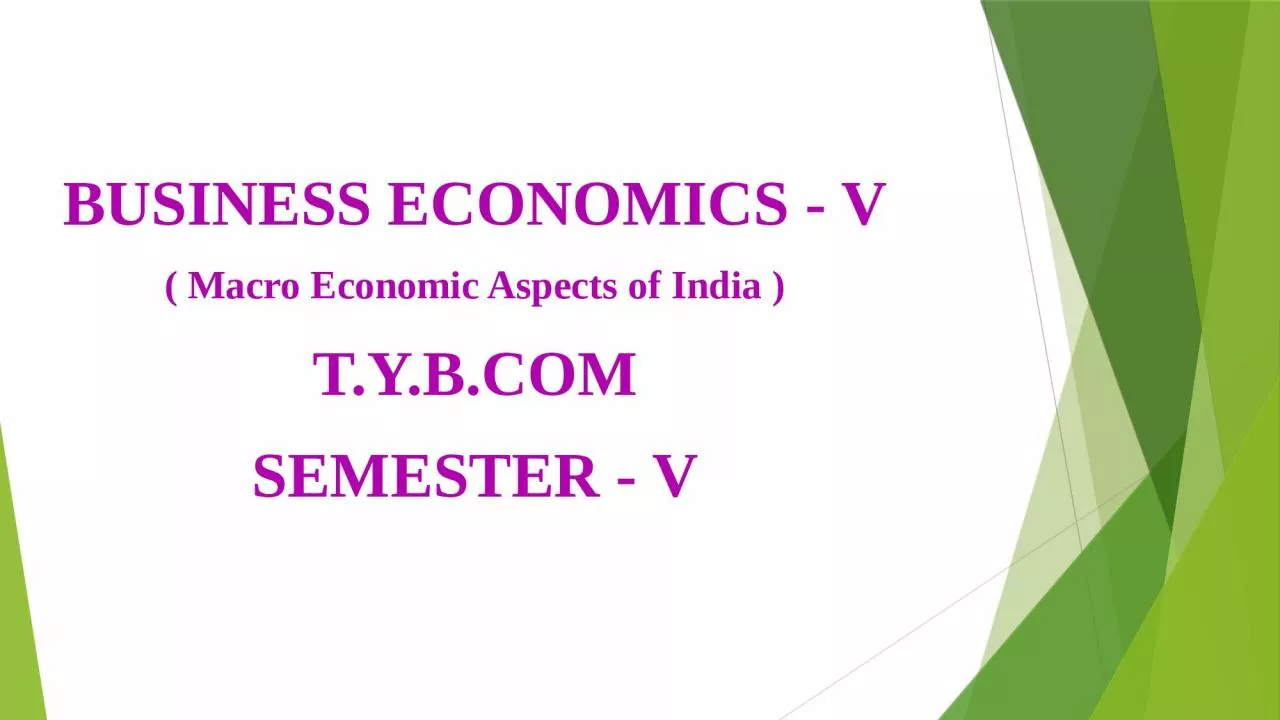

TYBCOM SEMESTER V MODULE I MICRO ECONOMIC OVERVIEW OF INDIA 1 NEW ECONOMIC POLICY 1991 11 INTRODUCTION The year 1991 is one of the most significant one of the economic history of ID: 1029891
Download Presentation The PPT/PDF document "BUSINESS ECONOMICS - V ( Macro Economic ..." is the property of its rightful owner. Permission is granted to download and print the materials on this web site for personal, non-commercial use only, and to display it on your personal computer provided you do not modify the materials and that you retain all copyright notices contained in the materials. By downloading content from our website, you accept the terms of this agreement.
1. BUSINESS ECONOMICS - V( Macro Economic Aspects of India )T.Y.B.COMSEMESTER - V
2.
3. MODULE - I MICRO ECONOMIC OVERVIEW OF INDIA
4. 1. NEW ECONOMIC POLICY 1991
5.
6. 1.1 INTRODUCTION The year 1991 is one of the most significant one of the economic history of India.The economy underwent some major shifts in its policies and functioning.
7. Since 1991, when India adopted the Five Year Plan,the economy was functioning as a mixed economy with government controlling some of the most strategic industrial sectors. There were several controls of the government over the use of resources by the private sector. These were in the form of industrial licensing,import licensing and controls,foreign exchange regulations,public monopoly in sectors, MRTP Act, control over the banking sector and capital market.
8. 1.2 THE RATIONALE Of NEW ECONOMIC POLICY (NEP) 1991
9. 1. Fiscal Crisis 2. Balance of Payments Crisis 3. High Inflationary Pressure
10. 1.3 IMPORTANT POLICY CHANGES IN NEP 1991
11. A . MACROECONOMIC STABILIZATION ( DEMAND MANAGEMENT)
12. 1. Control of Inflation2. Fiscal Correction3. Balance of Payments Adjustment
13. B . STRUCTURAL REFORMS ( SUPPLY SIDE MANAGEMENT)
14. 1. Industrial Sector Reforms
15. (a) Abolition of Industrial Licensing(b) Permitted Foreign investment and Foreign technology
16. (c) Reduced the role of public sector(d) Removal of MRTP limit
17. 2 . Public Sector Reforms and Disinvestment
18. 3 . Trade and Capital Flows Reforms
19. (i) Liberalization of imports(ii) Reduction in tariff structure(iii) Promotion of exports
20. (iv) Change in exchange rate policy(v) Introduced current account convertibility (vi) Liberalized capital inflows
21. 4. Financial Sector Reforms
22.
23. (A ) Banking Sector Reforms
24.
25. (i) Lowering of SLR(ii) Lowering of CRR(iii) Deregulation of Interest Rates
26. (iv) Introduction of Prudential Norms(v) Introduction of Capital Adequacy Norms(vi) Access to Capital Market
27. (vii) Entry of New Private Sector Banks (viii) Freedom of Operations(ix) Special Recovery Tribunals
28. (B )Capital Market Reforms
29. (i) SEBI as Statutory Body(ii) Primary Market Reforms(iii) Online Trading and Dematerialised Trading(iv) Rolling Settlement
30. (v)Investment by FIIs(vi) Investor Protection(vii) Derivative trading
31. (viii) Establishment of NSE(ix) Setting up of National Securities Clearing Corporation (NSCC)(x) Strengthening the Government Securities Market
32. ( C )Insurance Sector Reforms
33. Reference -Books :Website :
34.
35.